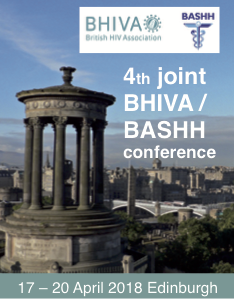Rapid PrEP uptake in Scotland exceeds expectations
1 May 2018. Related: Conference reports, HIV prevention and transmission, BHIVA/BASHH 4th Edinburgh 2018.
 Simon Collins, HIV i-Base
Simon Collins, HIV i-Base
Impressive results from NHS Scotland showed that providing PrEP in sexual health clinics is feasible with higher than expected uptake and reaches people at high risk who were previously not engaging in care.
These results on the first eight months of PrEP implementation were included in a poster presented by Nicola Steedman from NHS Scotland and colleagues. The coding system included eligibility (reasons for PrEP), dosing regimen and outcomes for whether PrEP was prescribed.
From July 2017 to February 2018, more than 117,000 individuals attended sexual health services and 8082 (7%) were gay or bisexual men. During the same period, 2517 PrEP prescriptions were provided to 1295 individuals, 96% of who were gay or bisexual men, with much lower use by women (n=10) or other/unknown (n=31).
This exceeded the 1000 places initially planned for the first year, with 16% of gay and bisexual men wanting to use PrEP. Of the 1780 people attending primarily for PrEP, 18% (n=328) were attending clinics for the first time and 27% (n=477) had not visited for more than two years, with similar percentages (17% and 24% respectively) going on to take PrEP.
Although limited details were provided on age, approximately 19% were under 25, 22% were 25-29, 29% were 30-49 and 30% were older than 40.
Results on dosing was available for 1028 people with 82% of people using daily dosing, 14% using event-based dosing and 3% using both.
Participants could have multiple codes for eligibility, but most common reasons were recent sex without condoms (80% of reasons) and recent STI (17% or reasons).
Of the 83 people offered PrEP who initially declined, 10 later decided to use PrEP, and most fulfilled eligibility criteria. Only 13 people decided to self-source PrEP online. PrEP was only contraindicated in six people.
comment
These remarkable results show that providing PrEP within NHS clinics is both feasible for clinics and highly acceptable for patients.
That approximately 25% of people had not attended a clinic in the previous two years and 20% were attending for the first time, with nearly all participants meeting eligibility criteria, shows the programme was highly effective at reaching people at high risk.
The rapid presentation of early results also shows that real world data collection from open-access services is also easily possible.
References
Steedman N et al. Were we PrEPared? Implementing HIV pre-exposure prophylaxis across Scotland: early analysis of the first eight months of NHS roll out . 4th Joint BHIVA/BASHH Conference, 17 – 20 April 2018, Edinburgh. Poster abstract P136. HIV Medicine, 19 (Suppl. 2), s21–s152.

